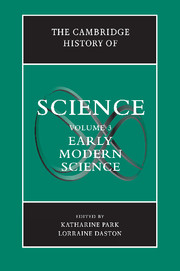Book contents
- Frontmatter
- 1 Introduction: The Age of the New
- Part I The New Nature
- Part II Personae and Sites of Natural Knowledge
- Part III Dividing the Study of Nature
- 17 Natural Philosophy
- 18 Medicine
- 19 Natural History
- 20 Cosmography
- 21 From Alchemy to “Chymistry”
- 22 Magic
- 23 Astrology
- 24 Astronomy
- 25 Acoustics and Optics
- 26 Mechanics
- 27 The Mechanical Arts
- 28 Pure Mathematics
- Part IV Cultural Meanings of Natural Knowledge
- Index
- References
26 - Mechanics
from Part III - Dividing the Study of Nature
Published online by Cambridge University Press: 28 March 2008
- Frontmatter
- 1 Introduction: The Age of the New
- Part I The New Nature
- Part II Personae and Sites of Natural Knowledge
- Part III Dividing the Study of Nature
- 17 Natural Philosophy
- 18 Medicine
- 19 Natural History
- 20 Cosmography
- 21 From Alchemy to “Chymistry”
- 22 Magic
- 23 Astrology
- 24 Astronomy
- 25 Acoustics and Optics
- 26 Mechanics
- 27 The Mechanical Arts
- 28 Pure Mathematics
- Part IV Cultural Meanings of Natural Knowledge
- Index
- References
Summary
This chapter is devoted to mechanics in the sixteenth and seventeenth centuries. Following a distinction traceable at least to Hero of Alexandria (first century) and Pappus of Alexandria (third century), mechanics can be divided into rational and practical (or applied). The former is a mathematical science normally proceeding by demonstration, the latter a manual art with practical aims. Here I privilege rational over practical mechanics, which is discussed elsewhere in this volume (see Bennett, Chapter 27).
A major problem with writing a history of mechanics during this period concerns the changing disciplinary boundaries and meaning of the term “mechanics.” Traditionally, mechanics had dealt with the mathematical science of simple machines and the equilibrium of bodies. In the second half of the seventeenth century, however, mechanics became increasingly associated with the science of motion. Therefore, in dealing with an earlier period, it is useful to chart not simply the transformations of mechanics as it was understood before the second half of the seventeenth century but also the relevant transformations in the science of motion that belong more properly to natural philosophy.
Mechanics and natural philosophy differed widely intellectually, institutionally, and socially in the period covered by this chapter. Even rational mechanics retained a practical and engineering component but it was also progressively gaining a higher intellectual status with the editions of major works from antiquity and with a renewed emphasis on its utility; initially its role in the universities was at best marginal, however. By contrast, natural philosophy had been a major academic discipline for centuries and had closer links to theology than to the practical arts.
Information
- Type
- Chapter
- Information
- The Cambridge History of Science , pp. 632 - 672Publisher: Cambridge University PressPrint publication year: 2006
References
Accessibility standard: Unknown
Why this information is here
This section outlines the accessibility features of this content - including support for screen readers, full keyboard navigation and high-contrast display options. This may not be relevant for you.Accessibility Information
- 7
- Cited by
